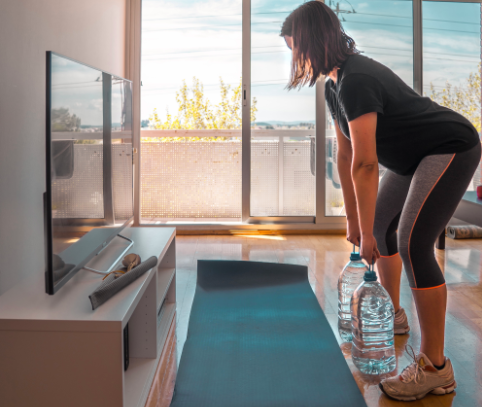IMPROVE MY GAME
Articles
The Home Workout: How To Keep Your Golf Strength And Conditioning On Track
Mon Jan 4, 2021 by Dr. Ben Langdown and Jennifer Fleischer

Working out at home is quickly becoming the new normal. And while at first it was impossible to imagine life without gym access and group classes, we’re starting to see how coaches are able to help their clients optimize workouts from home. With some careful consideration about your strength and conditioning (S&C) priorities, home workouts can be effective, and they also save travel time.
So we can see that working out at home and training our clients virtually offers unique opportunities, but what should a home golf fitness workout look like?
With lockdowns and stay at home orders, golfers not only scrambled to order nets for the backyard, they also invested in some equipment to take part in online high intensity interval training (HIIT) sessions. Following these types of HIIT workouts is great if you want to increase your muscular endurance, burn some calories and focus on your overall fitness levels. But general HIIT sessions are not what we suggest if you want to maximize your golf performance.
Strength, hypertrophy, speed and mobility should be the key priorities of a progressive golf fitness program — not cardio, agility, or even (in most instances) muscular endurance (except for where they are needed for a specific goal, or in prehab or rehab work to ensure the prevention of injury or the successful return to play after a period of injury).
We aren’t suggesting cardio work should never be done, but if you want to increase your ability to produce force and speed, then strength training is a critical (and often overlooked) part of a home golf fitness workout. And we understand why it’s easier to do cardio than lift weights from home! Without spending a small fortune on equipment, it can be difficult to hit the loads you need to lift in order to meet the key priorities of your training plan. Strength gains require you to lift >85% of your 1 repetition max (Table 1). Single effort power gains, another area specific to the demands of golf, require 80-90% 1RM. So, unless you already own a barbell and enough plates it’s likely that you’ll be looking around the house to find heavy objects to lift!
Golf demands that we produce high speed single efforts to hit the ball followed by a few minutes of walking (our chance to let the body recover from the single effort event!), and this sequence is repeated across the duration of a round. Therefore, if the goal of your golf fitness program is to increase clubhead speed and have your training transfer to the course, you need to prioritize the areas that are going to meet this goal and protect you against the demands of the sport. Alternatively, if you and your trainer decide the goal is to increase muscle mass (hypertrophy) as a route to increase clubhead speed then, again, you need to tailor the reps, sets, intensity and rest to the equipment you have access to at home. Check out Table 1 for training priority guidelines.
Table 1. Load, repetition and rest assignment based on training priority (adapted from Sheppard and Triplett, 2015).
To help you achieve your goals, here are some of our equipment hacks for strength training from home and examples of key exercises we use to keep our golfers strong and fast.
The Backpack: It’s almost impossible to hold more than two dumbbells all at once in your hands and train effectively, so load up a bag and wear it on your back, front – or both(!), or be imaginative and use it in other safe ways. First, ensure your bag is strong enough and then load it with weights and heavy items. This hack is great for squats, lunges, bent over rows, hip thrusts (with it placed on your lap), shoulder press, deadlifts, etc. If you’ve read our previous articles on developing lower body strength and upper body strength you know the role these types of exercises can play in a well-structured S&C program for your golf.
Exercise Examples:
-
Back Squats – If you don’t have a barbell and a squat rack, wear the loaded backpack and get squatting. For increased load consider holding some weights or using two backpacks – one on the back & front!
Laundry Detergent/Large Water Bottles: If you don’t have access to weights, you can use heavy laundry detergent or large water bottles. With the handles making them easy to grip, these bottles are a great hack for lighter kettlebells and dumbbells. Switch the liquid for wet sand or soil and you’ve just increased your load – the training principle of progressive overload in action!

Exercise Examples:
Power Bands: If you’ve read some of our previous posts, you know the significant results we’ve seen using mini-bands and other resistance bands e.g. in a dynamic golf warm-up. Not only just for warm-ups, power bands are a fantastic and less expensive way to add extra resistance to barbell and bodyweight exercises, such as squats and deadlifts. Tip: When exercises become too easy, increase the intensity by using a thicker power band.
Exercise Examples:

Furniture: When you’re struggling to find equipment to use at home you can always look to your furniture to help. Now, we’re not suggesting you climb the kitchen cupboards (unless you’re looking for increased grip and core strength?!) but you can consider using the edge of sofas for exercises like triceps dips, sturdy chairs as your gym bench, boxes or stools as steps, or even the dining table as a means to performing inverted rows.
Exercise Examples:
- Table Rows: Get under the table, grab hold of one edge with both hands, and row up to the table edge with your head and shoulders out from under the table. Your feet can stay on the floor or you can elevate them on chairs underneath the table, depending on how hard you want this exercise to be. Want to make this move even more challenging? Put on a weight-filled backpack to increase the load! This type of pull strength helps with postural control, scapula stability and the mobility at the shoulder joints all of which are important in the golf swing.
-
Single Leg Hip Thrusts – Shoulders on a chair: Glute strength is important for generating and transferring force from the ground up through the body in the swing. With adequate load, hip extension exercises are a great way to improve your glute strength.
-
Copenhagen. Having adequate adductor strength helps create more stability in the hip and knee, which can help you avoid common injuries in these joints over time. Adductor strength also aids in internal and external hip rotation, which is critical for those of you who struggle with sway and slide in your swing.
Speed: As we move further into the off-season, it’s important to consider adding speed training and explosive exercises into your plan. This type of training ensures that you can produce force as quickly as possible and will translate into increased clubhead speed on the course. Try adding explosive exercises such as the ones below into your program. If you can get out to the park, try adding in some med ball or slam ball exercises as well.
Exercise examples:
-
Squat Jumps
-
-
Slams
-
Rotational Throw
-
Split Stance Rotational Throw
-
Squat Jump & Throw
-
Chest Pass
-
Shotput
-
Mobility: Alongside all the strength, hypertrophy and speed work you may engage in, it’s important not to neglect mobility. Time to dust off your foam roller, find an old tennis ball or baseball and get to work on those tight spots from all the extra time you’ve been sitting at your desk throughout work from home restrictions. Also, check out how you can use power bands to work on calf and hamstring flexibility, internal hip rotation and even thoracic rotation.
Exercise examples:
-
Internal Hip Rotation – Place the trail leg outwards (internal rotation at the hip and turn the pelvis towards that hip. You can use a kettle bell inside the trail foot if it’s slipping inwards).
As you can see, there are endless options for adapting your golf fitness program for home use. However, it’s worth speaking to a suitably qualified and experienced golf fitness trainer to ensure your plan is appropriate for your specific needs and customized for the equipment you have at home.
For those of you looking to invest in some basics to get started, here is our equipment list:
Equipment List:
-
Power Bands: – e.g. thin, medium, thick.
-
Mini Bands: – e.g. light, heavy
-
Kettlebells
-
Barbell & Plates: (shop around - some kits come with a bench too)
-
Suspension Ttrainer: (some allow door attachment, others require an overhead attachment – use a strong, safe tree or solid roof beam, etc.)
-
Slam Ball: – e.g. 3-5kg (roughly 6-8 lbs) will suit most people to work on throws/slams.
-
Wall Mounted Squat Rack: (great for those of you with extra garage space — some even fold away when not in use)
While a quick cardio session may seem easier some days, we hope this article motivates you to continue your golf mobility, strength and speed training from home. Ensuring you stay on track with your set priorities is key during the off-season to allow you to emerge in the spring with increased strength and clubhead speed and further protection against injury. Be creative, adapt your training program and above all — be safe with the equipment you chose to use and stay healthy!

Dr. Ben Langdown was head of Sports Science at The PGA National Training Academy at The Belfry for over 10 years and is now a Senior Lecturer in Sports Coaching at The Open University (@OU_Sport). Alongside his golf research, Ben works with many elite amateur and professional golfers providing strength and conditioning support. Ben has a PhD in the field of golf biomechanics, studying movement variability and strength and conditioning for golf. Ben has presented research on athlete monitoring, relationships between physical screening and 3D golf swing kinematics and warm-up protocols at four previous WGFS. He has recently developed the AMI Sports: Golf® app, which is due to launch in early 2021 and will allow golfers to monitor and optimize their daily wellness alongside golf and training workloads. Follow Ben on Twitter.

Jennifer Fleischer is one of Golf Digest's 50 Best Golf-Fitness Trainers in America. She specializes in golf fitness and nutrition for a wide range of clients in the Bay Area and beyond. She recently launched Fleischer Tour Fit, a membership-based website that features weekly changing golf fitness workouts you can do anytime, anyplace. Follow her on Instagram or Twitter.
References: Sheppard, J.M. and Triplett, N.T. (2015) ‘Program Design for Resistance Training’ in Haff, G.G. and Triplett, N.T. (eds) Essentials of Strength Training and Conditioning, 4th edn, Champaign, Human Kinetics, pp. 439-469.